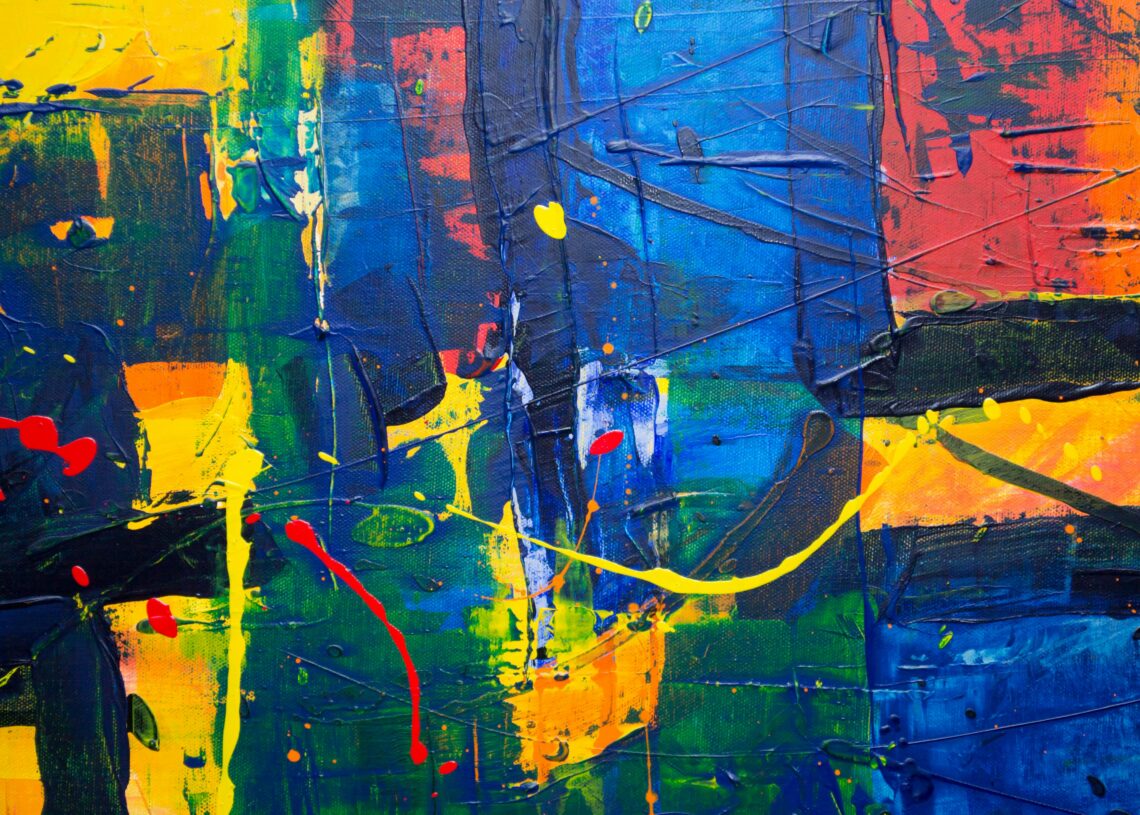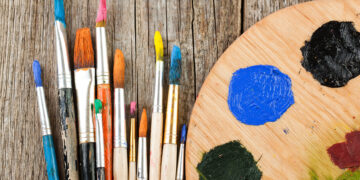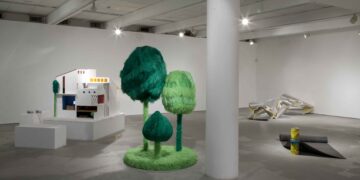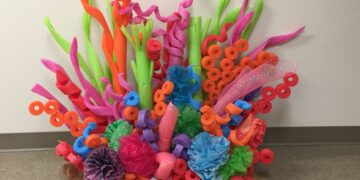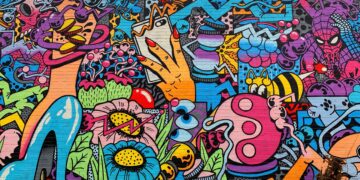The Evolving Essence of Abstraction
Abstract art is in constant flux, pushing past mere visual representation to engage with more profound emotional and experiential territories. This progression underscores the expressive capabilities of art, encouraging viewers to interact with pieces on a deeply personal and intuitive plane.
Emotional Priority
Contemporary abstract art places a premium on emotional and immersive experiences, moving away from the need for literal representation. Artists are increasingly focused on conveying intricate feelings and ideas through forms that defy concrete interpretation. This invites viewers to connect with the artwork on a visceral level, allowing for a more profound and individualized understanding.
The Grand Scale
Large-scale abstract works are gaining traction in both public and private spheres. These expansive pieces have the power to redefine spaces through the use of striking colors, dynamic brushwork, and compelling abstract forms. They transform environments, stimulating the senses and prompting deep personal responses.
Fresh Styles
New approaches, like Color Field painting—where color itself becomes the language of emotion—and action painting, which vividly captures the dynamism of the creative process, are rising in prominence. This surge reflects a broader cultural embrace of individuality and artistic freedom within the abstract art community.
Core Abstraction
The emphasis on the “spirit of abstraction” underscores an ongoing quest to move beyond the purely visual. Artists aim to connect directly with human emotion, intuition, and universal concepts, utilizing form, texture, and color as their primary communication tools. This intentional approach allows for a deeper, more meaningful engagement with the artwork.
Decoding Geometry: The Silent Language of Shapes
Abstract art often communicates through a language that goes beyond the representational. Geometric shapes, far from being mere forms, carry significant symbolic weight, adding to the emotional depth of abstract compositions.
Geometric Resurgence
Geometric patterns are making a notable comeback in the American art scene. Across both fine art and digital graphic design, these patterns are valued not only for their visual appeal but also for their ability to convey complex emotional states without relying on direct representation. This trend is capturing attention and reshaping creative landscapes.
Shape Symbolism
Artists are increasingly using geometric shapes—such as circles, triangles, and polygons—as a symbolic language. Each shape can evoke particular moods or psychological reactions. For example, circles often represent unity or infinity, while angular forms like triangles may suggest movement or even tension. This intentional use of geometry adds layers of meaning to abstract works.
Cultural Influences
The resurgence of geometric motifs is influenced by a broader cultural interest in retro aesthetics. The psychedelic styles of the 1960s, in particular, are finding new life in contemporary art. New technologies, like AI image generators, are also playing a role, enabling more experimental compositions and pushing the boundaries of what’s possible.
Transcending Imagery
This trend toward abstraction reflects a desire to move beyond literal imagery. Instead of focusing on narrative content, artists are inviting viewers into an emotional landscape shaped by form, color, and spatial relationships. It’s an invitation to engage with art on a more intuitive and personal level.
The Emotional Spectrum: Color in Abstract Expressionism
Abstract art utilizes the potent force of color to bypass literal representation, communicating directly with our emotions. Recent trends highlight the intentional use of color to evoke specific feelings within the evolving world of abstract expressionism.
Bold Hues
Abstract expressionism is experiencing a resurgence in both art and design. Artists are using color to communicate feeling, moving beyond just depicting things literally. Big, strong colors like emerald green, sapphire blue, and burgundy are being used to give paintings a sense of depth and movement.
Nostalgic Brights
Nostalgic bright colors, similar to those popular in the Y2K era, are making a statement. Shades like bubblegum pink and cyber yellow are being used to create feelings of optimism and energy. This shows how abstract art uses color to tap into shared cultural memories and associations.
Cool Tones
In response to global uncertainties, calming cool tones are also prominent. Colors such as misty blue, sage green, and pale lilac are favored for their ability to evoke tranquility and a sense of wellbeing. This reflects a deliberate choice to use color as a means of providing comfort.
Color Language
The use of color palettes in abstract art is becoming more curated. Artists carefully choose colors to elicit specific emotional responses, whether excitement, serenity, or nostalgia. The emotional language of color remains central to how abstract expressionism continues to change and develop.
The Power of Subtraction: Minimalism’s Allure
In a world of constant noise, minimalist abstract art offers a refreshing escape. Simplicity is captivating audiences and reshaping the art landscape.
Less is More
Abstract art, particularly the minimalist style, has seen growing interest from collectors and art institutions. This trend reflects a desire for emotional connection and individual interpretation in a world saturated with information. People are drawn to the ability of minimalist art to cut through the noise.
Complexity Distilled
Minimalist works are appreciated for their ability to distill complex ideas into essential forms. In a fast-paced world, these pieces offer moments of calm and introspection, providing a counterpoint to the visual overload of daily life. The focus is on what remains when everything unnecessary is removed.
Emerging Trends
Current trends include a growing demand for understated pieces that use soft pastels or earthy tones to evoke serenity. The increasing popularity of affordable prints has also made minimalist abstraction accessible to a wider audience, expanding its reach and influence.
Future Simplicity
Curators predict that the shift toward simplicity will continue. Minimalism’s influence is expected to grow as both a market force and an artistic strategy. This suggests a lasting impact on how art is created and appreciated, encouraging deeper emotional engagement beyond literal representation.
When Dreams Take Shape: The Surreal in Abstract Art
Dive into the captivating world where abstract art meets surrealism, creating dreamlike and emotionally resonant landscapes. This blend invites viewers on a journey beyond the literal, sparking imagination and stirring deep feelings.
Dreamlike Rise
Recently, there’s been a notable increase in interest in art that combines surrealist and abstract qualities. These pieces often evoke dreamscapes or strong emotional responses, drawing viewers into unique visual experiences. This trend highlights a desire for art that moves beyond simple representation.
Surrealism’s Broadening Appeal
Surrealism, once mainly associated with Europe, is gaining traction among collectors. Auction results, like Christie’s “Art of the Surreal” session, show significant engagement and sales, driven by American buyers. This indicates a shift towards appreciating art that explores the subconscious and fantastical.
Emotional Resonance
Experts suggest that collectors are drawn to the emotional depth found in abstract expressionism and modern surrealist painting. This preference for imagery that resonates on an emotional level underscores the power of art to communicate beyond the tangible. It reflects a desire for art that truly connects with the viewer.
Market Stability
Despite fluctuations in the art market, pieces inspired by surrealism remain highly sought after. This enduring appeal suggests that “dreamscape” motifs—where abstraction meets subconscious elements—are becoming central to contemporary art collecting. These motifs capture the evolving emotional landscape of art.
Abstract Surrealism
The merging of abstract and surreal elements is reshaping the art world. As collectors seek emotionally resonant and imaginative pieces, this trend is likely to continue influencing artistic expression. It promises a future where art delves deeper into the realms of dreams and emotions.
In recent years, the American art market has seen a surge of interest in Surrealist and abstract works that evoke dreamlike or emotional landscapes. Surrealism, once considered primarily European, is now increasingly popular among U.S. collectors. This trend is evident in auction results, such as Christie’s “Art of the Surreal” session, which saw record engagement and sales nearly double pre-sale estimates, with strong participation from American buyers. Experts attribute this to collectors’ desire for emotionally resonant imagery that transcends literal representation, a key feature of both abstract expressionism and modern surrealist painting. The market for established post-war and contemporary artists remains resilient, with blue-chip surrealist-inspired pieces highly sought after.
Data Source: Christie’s “Art of the Surreal” session.
Q&A
Question 1: How do contemporary artists utilize geometric shapes in abstract art, and what is the significance of this trend?
Answer: Contemporary artists employ geometric shapes as a symbolic language, assigning meaning beyond their literal forms. Circles might represent unity, while triangles could suggest tension or movement. This resurgence, influenced by retro aesthetics and new technologies like AI, reflects a desire to move beyond literal imagery and engage viewers on a more intuitive emotional level.
Question 2: What role does color play in conveying emotion in contemporary abstract art, and what are some examples of color palettes used to achieve specific effects?
Answer: Color is a powerful tool for directly communicating emotions in abstract art. Bold, strong colors create depth and movement; nostalgic brights evoke optimism and energy (like bubblegum pink and cyber yellow); while cool tones (misty blue, sage green) promote tranquility and well-being. Artists curate palettes to elicit specific emotional responses, demonstrating the evolving emotional language of color in abstract expressionism.
Question 3: How does minimalist abstract art contribute to the current artistic landscape, and what are some of its defining characteristics?
Answer: Minimalist abstract art offers a calming counterpoint to the information overload of modern life. Its simplicity allows for complex ideas to be distilled into essential forms, fostering individual interpretation and emotional connection. The use of soft pastels or earthy tones to evoke serenity, and the increased accessibility through affordable prints, are key trends driving its growing popularity.
Question 4: What is the significance of the growing interest in surrealist elements within abstract art, and what does this trend suggest about the future of the art form?
Answer: The blending of abstract and surrealist elements creates dreamlike landscapes that evoke strong emotional responses. This increasing popularity, evident in auction results and collector interest, signifies a desire for art that transcends literal representation and explores the subconscious. This trend suggests a future where abstract art delves deeper into the realms of dreams and emotions, emphasizing emotional resonance over purely visual elements.
